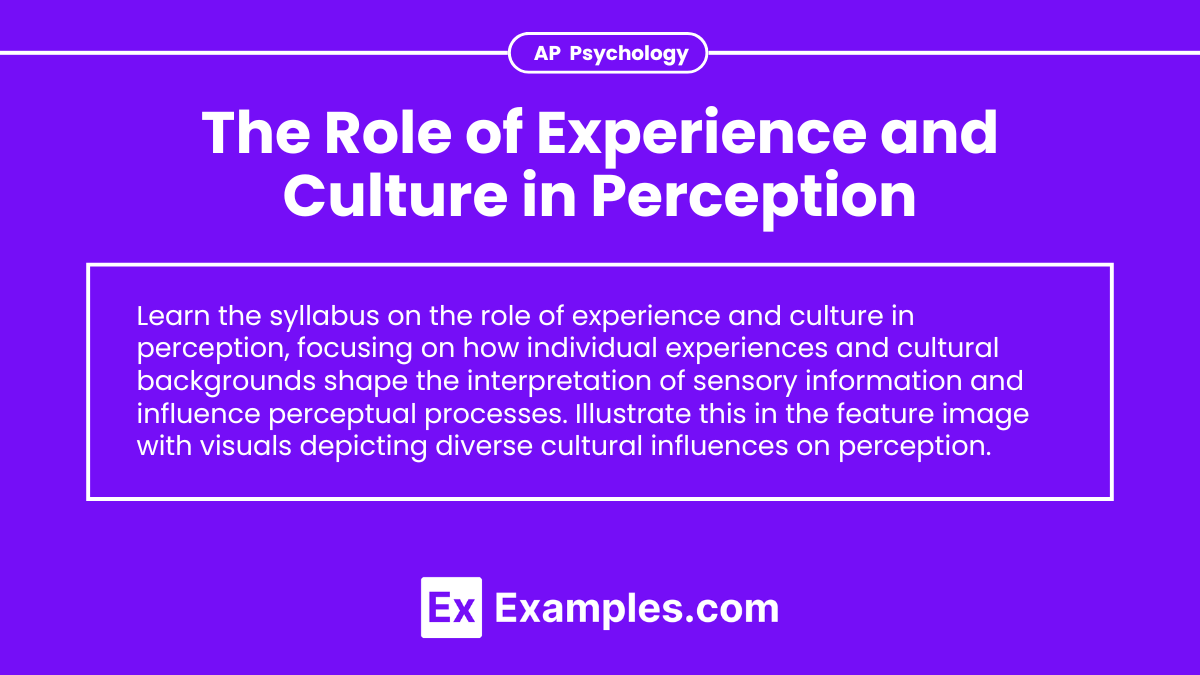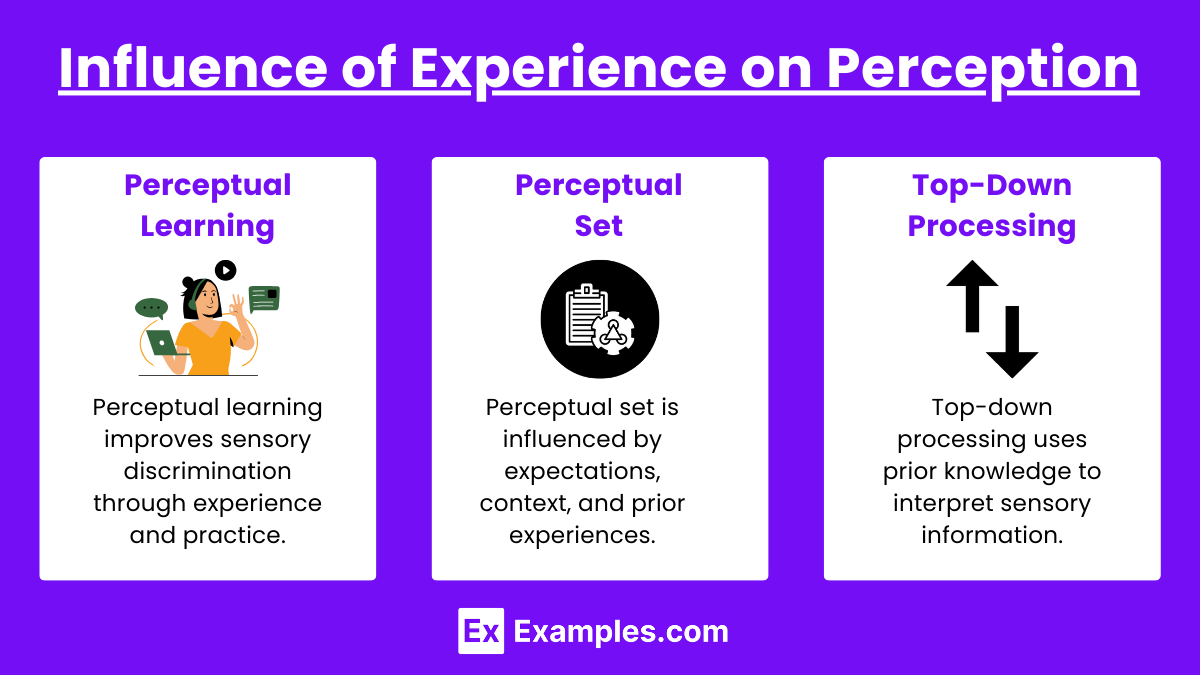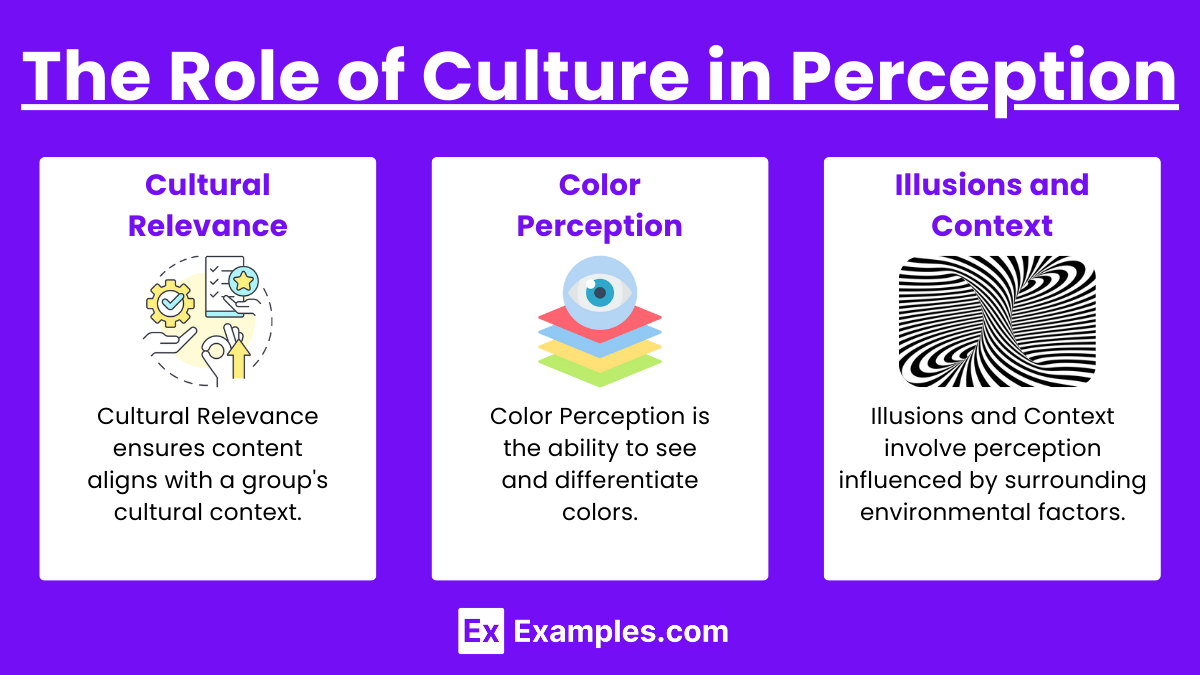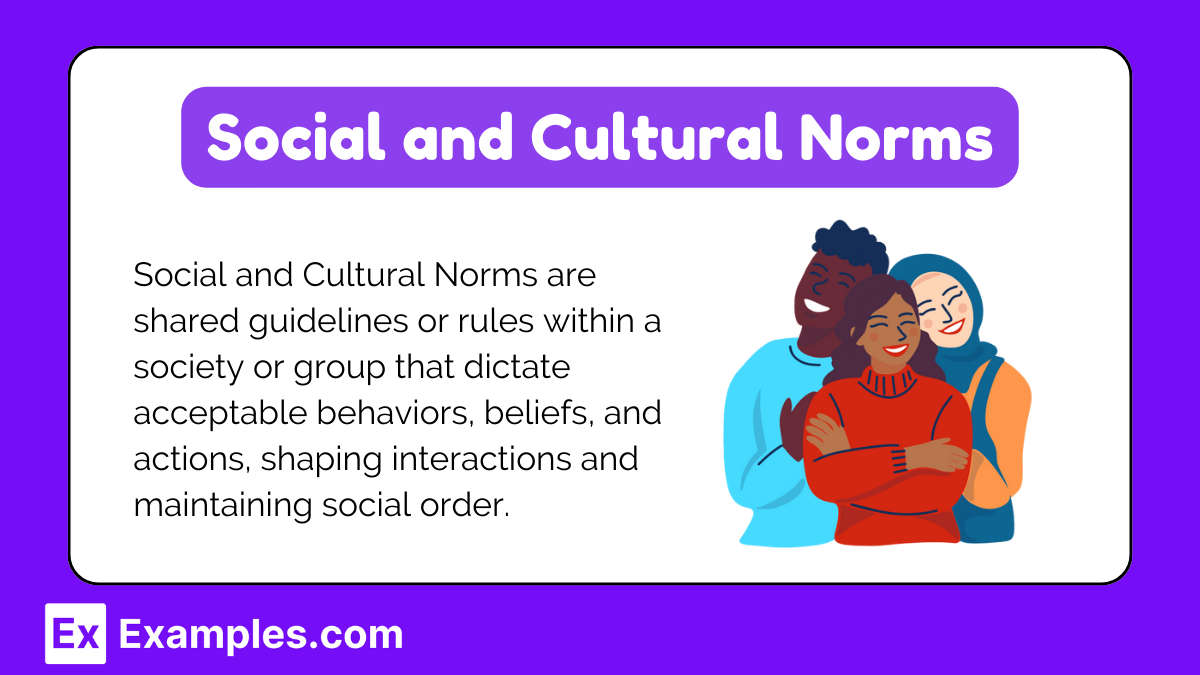Perception is the process by which we interpret sensory information to understand our environment. In AP Psychology, students explore how individual experiences and cultural backgrounds significantly shape this process. Our past experiences influence how we perceive and respond to stimuli, while cultural factors can dictate the norms and values that affect our perceptual interpretations. Understanding these influences is crucial for comprehending the diversity of human perception and its impact on behavior and cognition.
Learning Objectives
Understand how individual experiences and cultural backgrounds shape perception, influencing how we interpret sensory information. They should learn about cultural variations in perceptual processes, including how cultural norms and values affect attention, interpretation, and response to stimuli. Additionally, students should explore theories and research on perceptual differences across cultures, recognize the impact of prior experiences on perception, and apply this knowledge to real-world examples in psychology
Perception
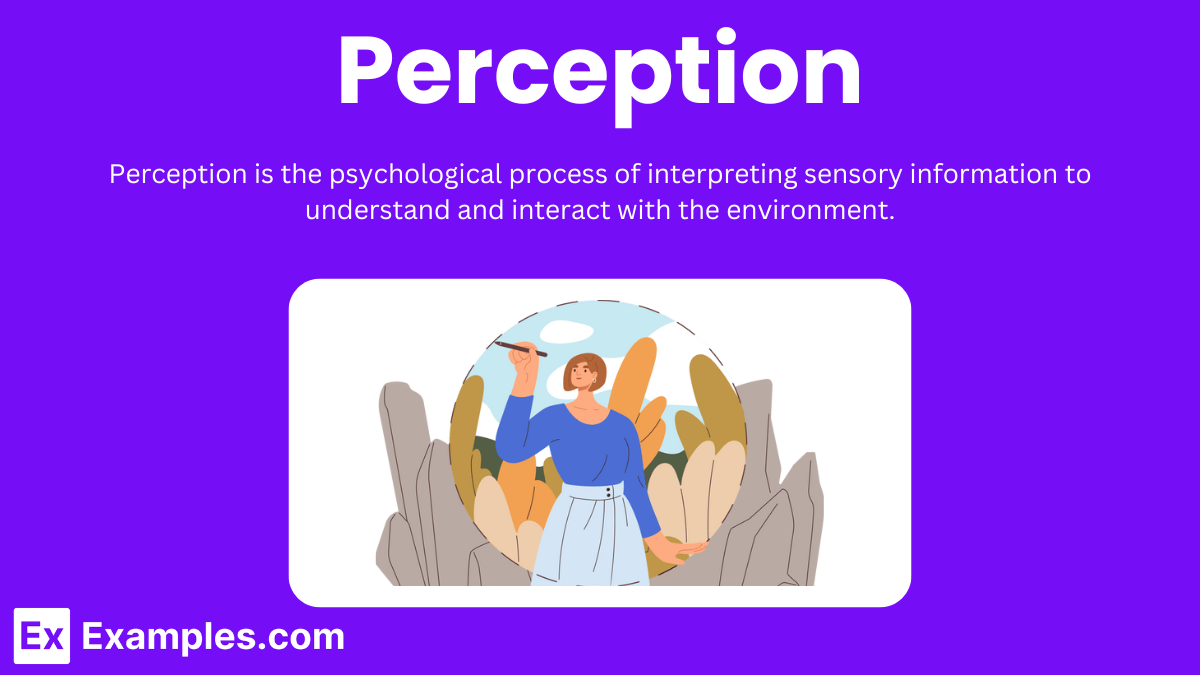
Perception is a fundamental psychological process through which we interpret and understand sensory information from our environment, ultimately forming our experience of the world. This complex process involves several stages and elements:
Sensory Input : Perception begins with sensory input, where our sense organs receive stimuli from the environment. This could involve any of our senses—sight, hearing, touch, taste, or smell. Each sense organ is adapted to receive specific data, such as light in the eyes or sound waves in the ears.
Transduction : The next step is transduction, where sensory receptors convert these stimuli into electrical impulses. These impulses are then transmitted to the brain. For example, in vision, light is converted into neural signals by the rods and cones in the retina.
Processing : Once in the brain, these signals are processed. This involves various areas of the brain, depending on the type of sensory information. For instance, visual information is processed in the visual cortex located in the occipital lobe. This stage includes both bottom-up processing (data-driven) and top-down processing (influenced by prior knowledge and expectations).
Interpretation : Interpretation is the stage where processed sensory information is given meaning based on context, previous knowledge, and cultural background. This is where perception diverges from mere sensation—perception is not just about receiving data but also understanding and making sense of it.
Response : Finally, perception leads to some form of response, whether it's a conscious action, an unconscious adjustment, a feeling, or a thought. The response is often aligned with the interpretation of the stimuli, influenced by motivational and emotional factors.
Key Characteristics of Perception
Selective Attention: The ability to focus on a specific aspect of experience while ignoring others, which is essential given the vast amount of sensory information available.
Organization: Perceptual organization involves arranging data into meaningful patterns, as demonstrated in phenomena like figure-ground relationships and grouping (as per Gestalt psychology).
Constancy: Perceptual constancy allows us to recognize objects without being deceived by changes in their appearance, such as variations in lighting, angle, or distance.
Perceptual Set: This is the readiness to perceive stimuli in a particular manner based on expectations that can speed up processing but may lead to errors.
2. The Influence of Experience on Perception
Perceptual Learning : Improvement in sensory abilities through experience, enhancing skills like recognizing patterns or details critical in specialized fields.
Perceptual Set : Tendency to notice specific aspects of sensory data based on expectations shaped by past experiences, influencing perception direction.
Top-Down Processing : Cognitive process where expectations and knowledge influence perception, leading to interpretation based on past experiences and context.
3. The Role of Culture in Perception
Cultural Relevance: People pay more attention to objects and events that are culturally significant. For example, Western cultures may focus more on individual elements, whereas Eastern cultures might emphasize the context or the group as a whole.
Color Perception: Different cultures have varying numbers of words for colors, which can affect how individuals from those cultures perceive them.
Illusions and Context: Cultural backgrounds can influence susceptibility to visual illusions. The Müller-Lyer illusion, for instance, has different effects on people from Western (more susceptible) and non-Western societies (less susceptible).
4. Schema Theory
Schema theory is a cognitive framework that explains how humans organize and interpret information using mental structures called schemas. These schemas are essentially clusters of knowledge, derived from prior experiences, that help individuals understand and respond to new information efficiently. Here’s how schema theory operates in cognitive processes:
Formation and Function
Schemas are formed through experiences and interactions with the world. Once developed, they allow individuals to quickly absorb and recall information by filling in the gaps with pre-existing knowledge. For example, a restaurant schema includes knowledge about the sequence of ordering, eating, and paying, which helps you navigate different dining experiences smoothly.
Types of Schemas
Role schemas: Expectations about how people in certain roles behave (e.g., teachers, doctors).
Event schemas (scripts): Guidelines for how common events usually unfold (e.g., visiting a doctor’s office).
Object schemas: Knowledge about physical objects and their properties.
Self-schemas: How individuals perceive themselves based on past experiences.
Influence on Perception and Memory
Schemas influence perception by shaping what people notice, think about, and remember. If information aligns with existing schemas, it is more easily understood and remembered. Conversely, information that does not fit can be distorted or overlooked, which demonstrates the schema’s role in biases and selective memory.
5. Social and Cultural Norms
Social and cultural norms are shared guidelines or rules that inform behaviors within a group, community, or culture. These norms significantly influence individual behavior, social interactions, and perception. Here’s an overview of how social and cultural norms operate:
Formation and Enforcement : Norms are typically formed over time through shared values and repeated interactions among group members. They are enforced socially through approval for conformity and disapproval or sanctions for deviations. For example, in many cultures, there are strong norms regarding how one should behave in formal settings, which dictate everything from dress code to language.
Influence on Perception : Norms influence perception by shaping expectations about what is "normal" or "acceptable" within a community. This perceptual bias can affect how individuals interpret and respond to various social situations. For instance, if it’s normative in a culture to maintain direct eye contact during conversations, failure to do so might be perceived as dishonesty or disinterest.
Cultural Variability : Norms can vary significantly between cultures and even within subgroups of a larger culture, affecting how people from different backgrounds perceive and interact with each other. This variability often leads to cultural misunderstandings or conflicts when implicit norms are not shared.
Dynamic Nature : Social and cultural norms are dynamic; they can evolve as societies change. Movements towards gender equality, for instance, reflect changing norms about gender roles within many societies.
Impact on Social Cohesion : Adherence to shared norms promotes social cohesion and contributes to the stability of social groups. It creates a sense of belonging among members and facilitates smoother, more predictable interactions.
6. Implications for Psychology

Understanding the role of experience and culture in perception has profound implications across various branches of psychology. Here are some key areas where these insights are particularly influential:
Clinical Psychology
Cultural Competence: Therapists must understand the cultural backgrounds of their clients to provide effective treatment. Misunderstandings arising from cultural differences in perception can impact diagnosis and therapy outcomes.
Treatment Adaptation: Techniques and interventions may need to be adapted to align with the cultural and experiential backgrounds of individuals to ensure their effectiveness and acceptance.
Cognitive Psychology
Perception Studies: Insights into how culture and experience shape perception can help in designing experiments and interpreting data about human cognition.
Memory and Learning: Understanding that memory reconstruction and learning are influenced by cultural and personal experiences can lead to improved educational strategies and learning outcomes.
Social Psychology
Group Dynamics: The role of cultural norms in shaping group behavior and the perception of group members is crucial for studying social interactions and dynamics.
Attitude Formation: Experiences and cultural background influence attitude formation, affecting how people perceive social issues, which in turn influences social behaviors.
Developmental Psychology
Child Development: The development of perceptual abilities is influenced by the cultural context in which a child grows up. This can affect cognitive and social development stages.
Language Acquisition: The language and communication styles children learn are deeply rooted in cultural practices, impacting how they perceive and describe the world.
Organizational Psychology
Workplace Diversity: Understanding how different cultural perceptions influence interaction can improve communication and cooperation in diverse work environments.
Leadership Styles: Effective leadership requires acknowledging and adapting to the cultural and experiential backgrounds of team members.
Educational Psychology
Learning Environments: Training in tailoring educational content and methods to cultural contexts enhances comprehension and engagement.
Bias in Education: Educators can be more aware of how their own cultural and experiential biases affect their teaching and interactions with students.

